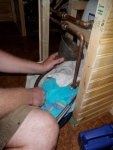Friday, October 7th, 2011:
The pressure testing went so much better than anticipated, but did lead to our first real problem solving situation.
We quickly realized once the water heater was fully pressurized that we’d likely have a need to drain it. It does not have a drain.
Hind sight being as clear as it tends to be, we recognized that we should have placed some sort of a valve in the thing. There is a hole in the top and in the side of the water heater allowing for placement of the pressure relief valve in either an upright or sideways tank orientation. We chose the upright orientation and put the pop off valve in the top of the unit. Then we placed the included brass plug in the side as instructed in the owner’s manual. But- once the water heater was full, how were we supposed to get the water out of it if we ever needed to move it?
Solution: We grabbed an old oil funnel, attached it to a hose that we then ran out the front door. Once in place we removed the plug, caught the gushing water before it hit the cork floor, and drained half of the water heater tank.
We now have a nice spigot with a valve in the water heater. Should we ever have to remove it, we’ll only be lifting 3 gallons of water instead of 7.
It appears that we still have so much more to learn. We’re looking forward to it!



Comments on: "Problem Solving, part ONE." (4)
Couldn’t you run the hot water tap after you turn the water into the house off?
Interesting suggestion. Not sure if it would work with no pressure and the water heater being below the level of the hot water lines.
Not a plumber, let me just say that first. I have had to replace a few water heaters in the past though. One thing I learned about them is they have an Galvanic anode in them, according to wiki it’s supposed to protect submerged metals from corrosion. In a water heater it protects the heater itself from corroding.
I only mention it, because from the pictures it looks a lot like the plug you removed. You might want to make sure that what you removed wasn’t the anode. I would also tend to think that a fiberglass water heater wouldn’t have an anode.
I have really enjoyed your blog, and your house is beautiful! Thank you for your hard work posting your progress it has really been a joy to see and read!
You are absolutely correct about the galvanic anode. This particular model has it attached to the pop-off valve that is installed in the top of the unit.
Thanks for your feedback and support!
Best,
Evan & Gabby